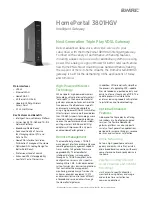
A3LA-RG Guide Version B
Document Number: 451-93156-009B
38 of 180
A
PPENDIX
A:
AT
I
NTERFACE
A.1 C
OMMAND
T
YPES
The A3LA-RG employs two principal types of AT commands: basic and extended. The two types
have differing syntax used to query and adjust their settings. They also have unique reference
standards. A specific basic AT command is used to reference S-registers and query and adjust
their settings. Its syntax is similar to that of extended AT commands.
A.2 B
ASIC
C
OMMANDS
Basic commands are industry standard and originally developed for Hayes-compatible PSTN
modems. In many cases, basic commands consist of a single ASCII alpha character. In other
cases, a special character precedes the alpha character. Prefix characters used in A3LA-RG basic
commands include &, \, %, and *.
Most alpha characters in basic commands are followed by a numeric parameter, n. To adjust its
setting, a basic command is entered with the appropriate numeric value of n. If the numeric
parameter n is omitted from the basic command entry, a value of zero is assumed for n. For
example, ATXn is set to a value of 4 by entering ATX4, whereas it is set to value of 0 by entering
either ATX0 or ATX.
To query a basic command setting, enter the AT&V command to view the active configuration
of a group of basic commands. Some basic commands listed in this document are marked with
“No action, compatibility only.” In these cases, the basic command is accepted in the same
fashion as it is with other modems, but has no effect on the operation of the A3LA-RG, because
it has no meaning in the Iridium environment.
A.3 E
XTENDED
C
OMMANDS
Extended commands perform actions or set parameters that extend the capability of the A3LA-
RG beyond that which is allowed by basic commands. In some cases, they were designed for
the GPS receiver, encryption, lock-up monitoring, and non-PSTN networks such as the GSM
network.
















































